Paris Opera Ballet / David H. Koch Theater, Lincoln Center, NYC / June 11-22, 2012
Say that, as a dance fan, you happen to have a young child in your life who’s showing a burgeoning interest in—perhaps even an instinctive love for—dancing. If you take her or him to the ballet to see one of the venerable 19th-century classics, you want to be sure it’s a production that’s faithful to its tradition—not savagely cut, skewed, or “reimagined” beyond recognition. The very young, with their acute receptivity, deserve the very best.
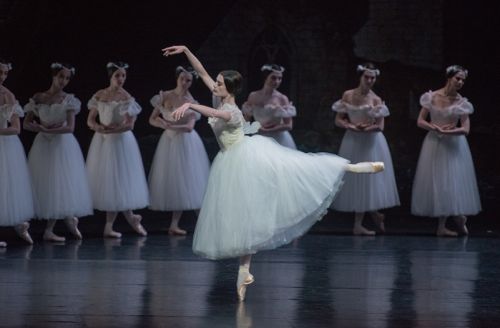 The Paris Opera Ballet’s Aurélie Dupont in the title role of Giselle, with the corps de ballet as wilis
The Paris Opera Ballet’s Aurélie Dupont in the title role of Giselle, with the corps de ballet as wilis
Photo: Stephanie Berger
I’ve had the pleasure and responsibility of fostering such a dance-avid child’s interest in ballet for a dozen years. (She’s 15 now—a scholar, a musician, and a runner.) We’ve had the luck of living in New York City, host to American Ballet Theatre, the New York City Ballet, and a plethora of ranking visiting troupes. As time went by, though, there was a diminishing number of satisfactory productions to be seen of touchstone works such as The Sleeping Beauty and Swan Lake.
Happily, the current visit of the Paris Opera Ballet has brought us the most beautiful and satisfying staging of Giselle that I’ve ever witnessed—and I, too, fell in love with ballet very young (without the help of a fairy godmother). Created for the company in 1841, this is a Giselle that sets the ballet where it belongs—in a pastoral community glowing with sunshine and good will until a dallying prince invades it (his excuse, he claims, is love), then in a dank graveyard populated by vengeful ghosts who can be vanquished only by a devotion existing beyond death (even then it’s a damned close call).
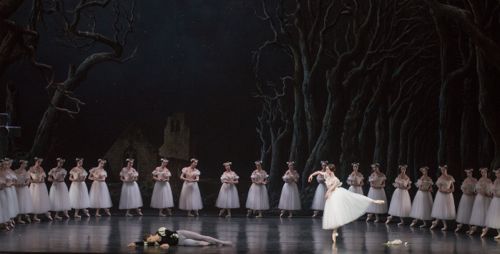 Dupont as Giselle, Mathieu Ganio as Albrecht, and the corps de ballet
Dupont as Giselle, Mathieu Ganio as Albrecht, and the corps de ballet
Photo: Stephanie Berger
Unusually, this production of Giselle is not entirely dependent on the ballerina playing the title role. Indeed, the work of the corps de ballet, 26 women, moving as one, creating one breathtaking sculptural image after another, is of equal—perhaps greater—importance. The interlacing lines of wilis (maidens who’ve died when their sweetheart betrayed them) crossing the stage in traveling arabesques made me gasp along with the neophyte viewers, though I’d seen the passage again and again. The stunning effect of the corps is no doubt due to the strict principles governing the dancers’ selection, their scrupulous training from childhood through adolescence (with many aspirants falling by the wayside) and, somehow, to their apparent communal dedication to animating the choreography at the highest level possible. It’s a zeal that never flags but is, instead, renewed night after night. I find all of this eerie and marvelous and feel privileged to witness it.
The costumes for the production, after those designed by the celebrated Alexandre Benois in 1924, are ravishing. The lower classes are modestly dressed. Then a procession of the aristocracy (to which the unreliable prince belongs), on its way to the hunt, brings rich color and magnificent detailing—in more or less medieval style—into the picture. The palette includes bright red, crimson, mulberry, violet, peach, cream, and deepest blue, the last offset with ermine trim. The complementary headgear is appropriately outré. Every last one of this 1% looks haughtily stunning.
In the second act, however, the wilis’ nearly surreal white costumes make the gorgeous worldly outfits we saw on the aristocracy look like mere gaudy outer skins of the earthly upper class. The wilis are clad in the uniform of their mystical if horrific rites. The ghostly women, veiled when we first see them, wear neat bodices above long tutus that flair out in quivering concentric circles when the women turn, as if creating a gently whirling cloud around their legs. From the back of their bodices sprout tiny translucent white wings. Where are they going to fly, I wondered, if they’re essentially dead and buried? No matter; once the second act is launched, susceptible observers will have entirely suspended their disbelief. They’ll see nothing but a stream of miracles.
Even the lighting of this Giselle is magical, most obviously in the slow coming of dawn, which robs the wilis of their power, saves the now-repentant prince’s life, and sends Giselle back to the sorrowful and lonely peace of her grave. It’s a peach-tinged light, a glow really, that increases as subtly as sleep finally arrives to an fretful insomniac.
As I write, I’ve seen three of the POB’s Giselles (and am signed up to see two more). By far the most gratifying was the first of them, Aurélie Dupont (whom I couldn’t resist visiting twice). The others were Clairemarie Osta and Isabelle Ciaravola.
Dupont is not the first ballerina you’d identify with Giselle. She has a devastating personal beauty (not necessary for the role, maybe even distracting) and an authoritative presence, no doubt encouraged by her years as an étoile–the A+ dancers of the company, according to its hierarchical system. Yet, as POB’s aesthetic dictates, she doesn’t “sell herself” but rather underplays and, in doing so, entices the viewer to join in the work of her imagination.
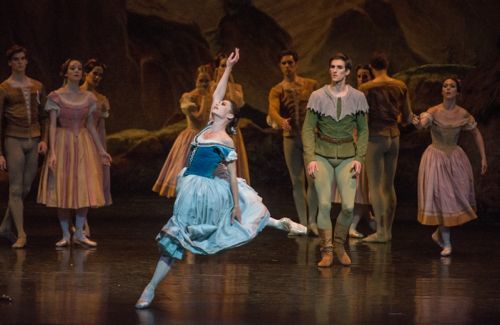 Dupont (center) as Giselle
Dupont (center) as Giselle
Photo: Stephanie Berger
In the first act of the ballet, her work is initially impressive only in the fluency and correctness of her dancing. But she’s a master of calibration and when she arrives at the Mad Scene she takes fire. First she looks like a child betrayed, then sketches the history she’s recalling of Albrecht’s (as the two-timing prince is called) courtship of her—making each feeble, jagged gesture a stab to the spectator’s heart, then leaping wildly here and there, as if to escape her sorrow.
Her second act was beyond terrific, her personal glamour sacrificed to create an image that was all air and pathos. She danced and acted as if those two elements might, quite naturally, be tethered to each other. At the moment of her appearance at the command of Myrtha, queen of the wilis, whirling as if seized by some untamable force of nature, she seemed to be a dead soul. Then, gradually, she achieved a piercing half-life through her memory of a love that refused to acknowledge death. She reacted to the now penitent and sorrowing Albrecht as if she didn’t actually see him and couldn’t really touch or be touched by him, yet somehow, deep within her senses, recalled an attachment to him that she would never abandon.
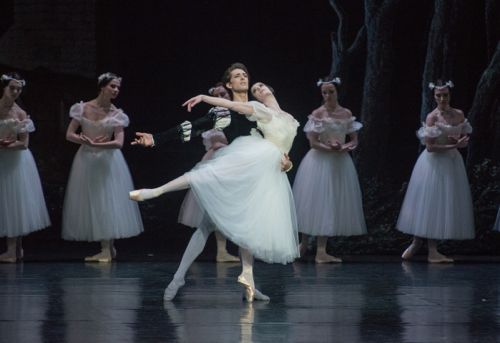 Dupont and Ganio as Giselle and Albrecht
Dupont and Ganio as Giselle and Albrecht
Photo: Stephanie Berger
In all this, she displayed two gifts essential to a ballerina: She makes you look at her (indeed refuses to let you look away) and she makes you believe in her.
Clairemarie Osta is a marvelous dancer—fresh, fleet, and buoyant. She’s no stranger to virtuoso feats where they’re appropriate. For one thing, she does the diagonal of hops on pointe traveling backwards—without in the least seeming to show off. Her Mad Scene has personal touches that are entirely apt. Overall she plays it as if she had slept while the prince-playing-peasant courted her and she responded with shy joy, and has now awakened to a nightmare. And yet Osta’s never entirely convincing as Giselle because she’s just not the type. She doesn’t come across as a fragile, vulnerable young woman to whom tragic things happen. She has the delicious personality of a soubrette; a born Lise in La Fille mal gardée.
Isabelle Ciaravola didn’t endear herself to me in L’Arlésienne and my lack of enthusiasm continued upon seeing her Giselle. Like her fellow étoiles she is amazingly capable. Still, the rank of étoile is supposed to be given for a charisma, a luminescence that is beyond technique. Instead I find Ciaravola dry, angular, even occasionally grotesque, as if she were activated by an unreliable puppet master maneuvering the strings. I’d prefer not to be so negative—especially about a dancer I’d never seen before now—but I understand, just from intermission talk, that she has many admirers, so if I can’t see what’s terrific about her, no matter. That’s the beauty inherent in having a diversity of dancers to interpret a role. The Parisians fielded four in New York and, with three of these close to retirement, no doubt have other candidates back home.
None of the Albrechts I saw seemed just right for the role, one too young and brash paired with a mature ballerina; another too mature to negotiate the technical challenges, though theatrically wise; a third who, with everything going for him, remained indifferent to the story the ballet means to tell. The men’s partnering, though, particularly in the second act, never faltered.
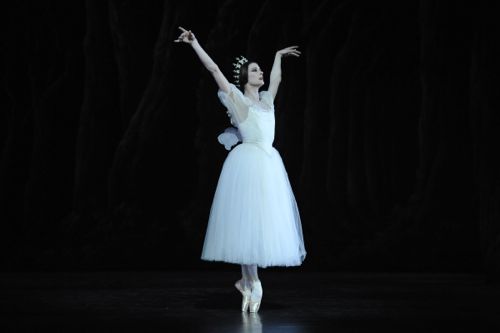 Marie-Agnès Gillot as Myrtha, Queen of the Wilis, in Giselle
Marie-Agnès Gillot as Myrtha, Queen of the Wilis, in Giselle
Photo: Stephanie Berger
As Myrtha, I much preferred Marie-Agnès Gillot, who alone had the force the role demands and a rare range of emotion. Gillot is one of the most versatile and impressive dancers in the august French company, and her presence permeates the entire second act—until Giselle’s literally undying love for Albrecht defeats her. Emilie Cozette, the first-cast Myrtha, was sweet, small, and tender. What had Casting been thinking of?
Apart from the excellence of the dancing, the company’s style in mime is ideal. Even when it’s in the traditional code vocabulary (for example, tracing a circle around the face means “beautiful”), it’s very underplayed—conversational, as it were. The POB dancers behave as if dancing were their poetry, mime their prose, and the two were intimately related. Think of the relationship between aria and recitative in opera.
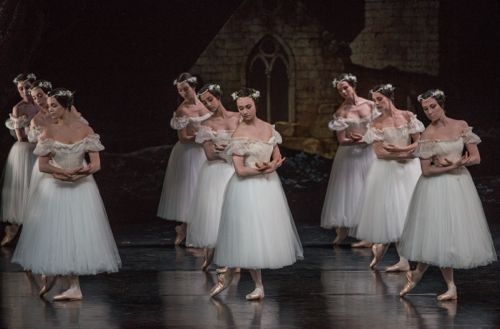 The corps de ballet as wilis
The corps de ballet as wilis
Photo: Stephanie Berger
A minor but telling detail (one of many, the Parisians being well-nigh obsessive about detail): Just as in the lithographs of Romantic Age ballerinas, the wilis carry their heads inclined slightly forward, drawing attention to the back of the neck (la nuque, in French)—a part of the body that, according to Japanese culture, is considered particularly beautiful and erotic. Evidently, the Japanese are right.
Led by the Belgian conductor Koen Kessels, the orchestra of the New York City Opera delivered Adolphe Adam’s score sensitively and vibrantly. Ballet music is rarely so well treated in New York. It was a pleasure to hear what’s possible, given care and financial support.
© 2012 Tobi Tobias




You are COOKIN’ tt……
I only saw the Saturday matinee performance of “Giselle” with Isabelle Ciaravola in the title role. I was most impressed with the consistent company style of the Paris Opera Ballet, not surprising as the dancers are nearly all French and trained from a young age at the POB School. My favorite performer was Marie-Agnes Gillot as Myrtha, backed up by the breathtaking corps of Willis. I also loved seeing the 1924 Alexandre Benois designs for this production; both sets and costumes had a fairy tale quality and Act II was particularly atmospheric. To me the star of the afternoon was the superb corps de ballet.
To quote you, Tobi, “I’d prefer not to be so negative” … but the POB has trotted out its old warhorses (or as you more delicately put it, ballerinas “close to retirement”) to dance Giselle on this American tour. But that’s their preogative, in the overly hierarchical structure of the company. Which is a shame, because there are several younger dancers who have not achieved the rank of Etoile, who do a much more credible job of convincing the audience that they are watching a vulnerable teenager whose heart has been broken. (I should know, as my cousin is one of them.)
I’m still yelping–ahoo!
Thank you, Tobi, again and again for such “cookin’ it” writing. I would like to add my profound agreement with your opening statement about wanting the young to see the best, truest productions of the “classics.”
A number of years ago, Christopher Wheeldon did for the Pennsylvania Ballet a “Swan Lake” that was meant to tie in to a Degas exhibition at the Philadelphia Art Institute that was showing concurrently, or had just shown, can’t remember which. So he set his “Swan Lake” at the Paris Opera Ballet; his Siegfried was a dancer rehearsing for SL, who dreams of “Swan Lake” during his practice (rather elegant video was part of it). That’s Acts One and Two, during which the prince does not promise to be faithful, thus removing the motivation for the story. The diverts that usually take place in the ballroom in Act III were Folies Bergères acts taking place in the vestibule of the POB for the abonnés and included a can-can. At the end our dancer/Siegfried awakens in the studio and continues to rehearse.
My point is that sitting next to me was a young boy with his father, who was seeing “Swan Lake” for the first time. I was heartsick, for he wasn’t in fact, seeing the “real” ballet, as innovative and beautiful as much of Wheeldon’s choreography was.
Thank you for the wonderfully compelling and descriptive review of Paris Opera Ballet’s “Giselle.” I’m sorry to have missed the opportunity to see it, but reading your response is so nourishing.
I was glad to read your review of Paris Opera Ballet’s “Giselle.” I’m sorry I didn’t see one of the other ballerinas in the title role. However seeing Marie-Agnes Gillot as Myrtha was a treat.
I have to admit I love the guest stars at ABT, especially Alina Cojocaru. (Osipova and Vishneva are no longer technically guest stars, I suppose.) Their dancing can be heart-stopping, but there is something to be said for a true company style which POB has and ABT really doesn’t.
Also, “Giselle” is my favorite of the old story ballets. Act II is rivaled only by the Shades act in “La Bayadère.” I never tire of seeing “Giselle,” even when the productions are not all they should be. I’ve seen it many times. One that stands out in my memory: Antoinette Sibley and Anthony Dowell at the Royal Ballet, the only time I was lucky enough to see the company in London.
Great review as usual, Tobi.
The only thing I don’t agree with is Ciaravola as Giselle. Looking at the images I shot, her Mad Scene in particular is very moving. I hope you liked Gilbert and Hoffalt.
My thoughts on Paris Opera Ballet’s “Giselle”: I was impressed with the elegance and technique, FOR A WHILE, but I didn’t like all the updating changes, etc. After a while I felt as if I were watching a chorus line; all we needed was the cancan. I think that Dupont has class and precision, but it wears out fast on me, especially when the Adam music is almost ump-pa-pa. Not my idea of the great renditions of “Giselle” that I’ve seen, although the one bravura male showoff in Act I was worth the $25. I think it was the Hilarion dancer–or it could have been Albrecht. I was having trouble distinguishing the two in the first act.
I really screwed up this time and didn’t try to get tickets until it was too late. So I will miss all the performances of the Paris Opera Ballet, although I will see them in Paris. Perhaps I will get to see the “Giselle,” which I have never seen that company perform. Your review made me really sorry I missed it.
I did see an all-Roland Petit evening in Paris a few years ago — “Le Loup,” “Carmen,” and “Le Jeune homme et la mort,” and I must say they danced beautifully. Even when Roland Petit is too populist and repetitive, he is very sexy and expressive, and oh, so post-war existentialist — which I love.
As always your review was fascinating, especially your discussion of the traditions the company brings to “Giselle.” The positioning of the neck was also something I noticed in the Kirov/Maryinsky’s production of “Les Sylphides” some years ago when they performed it at City Center. Straight out of the lithographs.
Looking forward to more reviews, especially the Pina Bausch.
My friends and I liked Dupont the least, but we did like Ciaravola and Osta as well as tonight’s Gilbert. All of the Albrechts’ entrechats were impressive. I like a few aspects of the ABT production better, though the POB’s Peasant Pas de Deux has more elegant choreography. I wish the NYCO orchestra had played the original orchestration better. Tonight’s Myrtha and Hilarion seem to have been the best.
Tobi, while I am not changing my mind from my earlier Comment, I had written it before I read your incredible review, which was tremendously enlightening. Part of my problem was sitting way at the top of the 4th Ring, and at the New York State Theater, that’s usually death. (Please note that I refuse to call the house by its new name, for political reasons.) Needless to say, you cannot see personal beauty, facial expressions, and the other “details” you alluded to at that height, although the feet were always prominent. I thank you for your educational perspective. Next time I’ll get tickets right away, not at the last minute.
With binoculars I had no trouble seeing facial expressions and other “details” in the Paris Opera Ballet’s performances from the 4th Ring of the David H. Koch Theater. In addition, I could appreciate the full corps and the patterns which are not as apparent when sitting closer. I preferred my 4th Ring seat to my 2nd Ring. When I sit in the orchestra it’s a crap shoot whether I’ll be blocked by heads in front of me.
I saw POB’s “Giselle” three times. Good production. I saw “Bolero” and then the Pina Bausch thing tonight. I liked “Giselle.”
As a critic, I’m often given the privilege of being seated in the Orchestra at the David H. Koch Theater. I certainly appreciate this, but have the same problems with the sight lines there that you describe.
It was a pleasure for me to read your review after having seen “Giselle” on Friday evening. I do not get to the ballet often, but found myself beaming in the first act, and mesmerized in the second. Indeed, just as you mention, I WAS taken by the wilis’ fluid movements as they wove across the the stage. I was so pleased to read your take on this production because it supported this neophyte’s delight at seeing the performance! Brava!
Tobi, what a gorgeous piece. (As you can see, I’m catching up.) You describe the performance with such gusto and feeling that it made me wish I’d been there. Alas, these things only happen when they happen. But at least there are your words to bring it to life.
Dear Tobi,
in this piece you really captured the essence of the Romantic ballet. I felt like being there with you. Just wonderful writing.
Jeannette